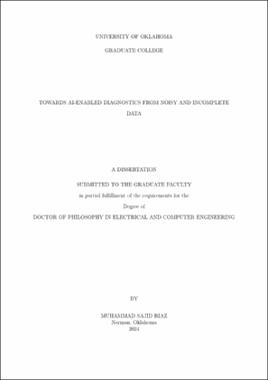| dc.contributor.advisor | Imran, Ali | |
| dc.contributor.author | Riaz, Muhammad Sajid | |
| dc.date.accessioned | 2024-05-03T18:38:41Z | |
| dc.date.available | 2024-05-03T18:38:41Z | |
| dc.date.issued | 2024-05-10 | |
| dc.identifier.uri | https://hdl.handle.net/11244/340287 | |
| dc.description.abstract | The advent of artificial intelligence (AI) has revolutionized diagnostic procedures, promising enhanced accuracy and efficiency across various domains. This dissertation leverages AI capabilities for diagnostic purposes, particularly focusing on the challenges posed by noisy and incomplete data, with a specific emphasis on image and audio data modalities.
The modern diagnostic landscape often encounters datasets fraught with noise and incompleteness, stemming from diverse sources such as sensor limitations, environmental factors, or inherent complexities in the data collection process. Addressing these challenges necessitates the development of robust AI methodologies capable of extracting meaningful insights despite the presence of imperfections.
This research endeavors to bridge this gap by proposing innovative AI techniques tailored to handle noisy and incomplete image and audio data. One of the major contributions of this dissertation is a hybrid deep learning-based framework (HYDRA) for root cause analysis of coverage anomalies in emerging cellular networks using minimization of drive tests (MDT) reports. A complete schematic, detailed design, and comparative analysis of HYDRA are given in chapter II of this dissertation. The main objective of this research was to devise novel algorithms that can effectively mitigate the adverse effects of noise and
incompleteness, thereby enhancing the reliability and accuracy of diagnostic outcomes.
Furthermore, this study adopts a multi-faceted approach, encompassing both theoretical advancements and practical implementations of a concept framework for proactive future pandemic prediction leveraging multi-modal biosensing data. This approach is presented in the dissertation as a framework called iPREDICT, which leverages the power of deep
learning architectures, a plethora of biomarkers acquired using free-life biosensors available in daily life usage smart devices like smartwatches and smartphones.
Moreover, the practical significance of this research extends beyond academic realms, with potential applications spanning diverse sectors such as healthcare diagnostics, emerging cellular networks, and biomedical signal processing. By empowering AI systems to navigate through the complexities of noisy and incomplete data, this dissertation endeavors to pave the way for more robust and dependable diagnostic tools, ultimately contributing to improved decision-making processes and enhanced societal well-being.
In summary, this dissertation represents a significant step towards realizing the full potential of AI-enabled diagnostics in real-world scenarios characterized by noisy and incomplete data. Through a synergy of cutting-edge AI methodologies and practical insights,
this research aspires to catalyze advancements that will shape the future of diagnostic
technologies across multiple domains. | en_US |
| dc.language | en_US | en_US |
| dc.rights | Attribution 4.0 International | * |
| dc.rights.uri | https://creativecommons.org/licenses/by/4.0/ | * |
| dc.subject | AI-enabled Diagnostics | en_US |
| dc.subject | Root cause analysis | en_US |
| dc.subject | coverage anomalies in cellular networks | en_US |
| dc.subject | diagnostics from noisy data | en_US |
| dc.subject | data sparsity and enrichment | en_US |
| dc.subject | HYDRA | en_US |
| dc.subject | iPREDICT | en_US |
| dc.title | TOWARDS AI-ENABLED DIAGNOSTICS FROM NOISY AND INCOMPLETE DATA | en_US |
| dc.contributor.committeeMember | Ford, Timothy | |
| dc.contributor.committeeMember | Cheng, Samuel | |
| dc.contributor.committeeMember | Tang, Choon Yik | |
| dc.date.manuscript | 2024-04-25 | |
| dc.thesis.degree | Ph.D. | en_US |
| ou.group | Gallogly College of Engineering::School of Electrical and Computer Engineering | en_US |
| shareok.orcid | 0000 - 0001 - 8827 - 0176 | en_US |

